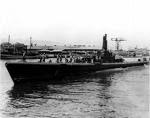|
USS Tang, SS-306, the most successful US submarine of WW-II sunk by her own faulty torpedo
 USS Tang, SS-306 was a Second World War era Balao class submarine. Built by Mare Island Naval Shipyard and launched on August 17, 1943, she was commissioned on 15 October 1943 and delivered to the Navy on November 30 1943. USS Tang, SS-306 was a Second World War era Balao class submarine. Built by Mare Island Naval Shipyard and launched on August 17, 1943, she was commissioned on 15 October 1943 and delivered to the Navy on November 30 1943.
Tang completed fitting out at Mare Island and then moved south to San Diego, California, for 18 days of intensive training before sailing for Hawaii. She arrived at Pearl Harbor on January 8th 1944 and conducted two more weeks of exercises in preparation for combat. Tang stood out of Pearl Harbor on 22ed January to begin her first war patrol in the Caroline Islands-Mariana Islands area.
Final patrol, from the report of her surviving commanding cfficer
On the night of 10 October and 11 October, Tang sank the cargo ships Joshu Go and Ōita Maru. The submarine continued on patrol until 23 October when she contacted a large convoy consisting of three tankers, a transport, a freighter, and numerous escorts. Commander O`Kane planned a night surface attack. Tang broke into the middle of the formation, firing torpedoes as she closed the tankers (later identified as freighters). Two torpedoes struck under the stack and engine room of the nearest, a single burst into the stern of the middle one, and two exploded under the stack and engine space of the farthest. The first torpedoes began exploding before the last was fired, and all hit their targets, which were soon either blazing or sinking. As the submarine prepared to fire at the tanker which was crossing her stern, she sighted the transport bearing down on her in an attempt to ram.
Tang had no room to dive so she crossed the transport`s bow and with full left rudder saved her stern and got inside the transport`s turning circle. The transport was forced to continue her swing to avoid the tanker which had also been coming in to ram. The tanker struck the transport`s starboard quarter shortly after the submarine fired four stern torpedoes along their double length at a range of 400 yards. The tanker sank bow first and the transport had a 30-degree up-angle. With escorts approaching on the port bow and beam and a destroyer closing on the port quarter,
Tang rang up full speed and headed for open water. When the submarine was 6000 yards from the transport, another explosion was observed aboard that ill-fated ship, and its bow disappeared.
On the morning of 25 October, Tang began patrolling at periscope level. She surfaced at dark and headed for Turnabout Island. On approaching the island, the submarine`s surface search radar showed so many blips that it was almost useless. Tang soon identified a large convoy which contained tankers with planes on their decks and transports with crated planes stacked on their bows and sterns. As the submarine tracked the Japanese ships along the coast, the enemy escorts became suspicious, and the escort commander began signaling with a large searchlight. This illuminated the convoy, and Tang chose a large three-deck transport as her first target, a smaller transport as the second, and a large tanker as the third. Their ranges varied from 900 to 1400 yards. After firing two torpedoes at each target, the submarine paralleled the convoy to choose its next victims. She launched stern torpedoes at another transport and tanker aft.
As Tang poured on full speed to escape the gunfire directed at her, a destroyer passed around the stern of the transport and headed for the submarine. The tanker exploded, and a hit was seen on the transport. A few seconds later, the destroyer exploded, either from intercepting Tang’s third torpedo or from shell fire of two escorts closing on the beam. Only the transport remained afloat, and it was dead in the water. The submarine cleared to 10,000 yards, rechecked the last two torpedoes which had been loaded in the bow tubes; and returned to finish off the transport.
The twenty-third torpedo was fired at 900 yards and was observed running hot and straight (`hot` meaning the engine had ignited). At 0230 on the morning of 25 October, the twenty-fourth, last torpedo was fired. It broached and curved to the left in a circular run. Tang fishtailed under emergency power to clear the turning circle of the torpedo, but it struck her abreast the aft torpedo room approximately 20 seconds after it was fired. Tang sank by the stern. Those who escaped the submarine were greeted in the morning with the bow of the transport sticking straight out of the water. Nine survivors, including the commanding officer, were picked up the next morning by a Japanese destroyer escort.
A total of 74 men were lost. When the nine survivors were picked up by a destroyer escort, there were victims of Tang’s previous sinkings on board, and they tortured the men from Tang. The nine captives were retained by the Japanese in prison camps until the end of the war,
Awards
Tang received four battle stars and two Presidential Unit Citations for World War II service. Her commanding officer received the Medal of Honor for Tang’s final action.
Tang is credited with sinking 31 ships in her five patrols, totaling 227,800 tons, and damaging two for 4,100 tons. This record is unequaled among American submarines.
 |
Saint Thomas |
2008 |
US Submarine USS Tang, SS-306 (Balao class) |
|